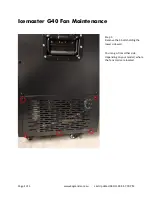
21
The mesh size of the filter must be 1.2 mm. If this filter is
not installed, the plate heat exchanger can quickly become
contaminated at the first start-up, as it takes on the filter
function, and correct unit operation is affected (reduced
water flow due to increased pressure drop).
Before the system start-up verify that the water circuits are
connected to the appropriate heat exchangers (e.g. no reversal
between evaporator and condenser).
Do not introduce any significant static or dynamic pressure
into the heat exchange circuit (with regard to the design
operating pressures).
Before any start-up verify that the heat exchange fluid is
compatible with the materials and the water circuit coating.
In case additives or other fluids than those recommended by
Carrier are used, ensure that the fluids are not considered as a
gas, and that they belong to class 2, as defined in directive
97/23/EC.
Carrier recommendations on heat exchange fluids:
1. No NH
4+
ammonium ions in the water, they are very
detrimental for copper. This is one of the most important
factors for the operating life of copper piping. A
con-tent of several tenths of mg/l will badly corrode
the copper over time (the plate heat exchangers used
for these units have brazed copper joints).
2. Cl
-
Chloride ions are detrimental for copper with a risk
of perforations by corrosion by puncture. If possible
keep below 10 mg/l.
3. SO
4
2-
sulphate ions can cause perforating corrosion, if
their content is above 30 mg/l.
4. No fluoride ions (<0.1 mg/l).
5. No Fe
2+
and Fe
3+
ions with non negligible levels of
dis-solved oxygen must be present. Dissolved iron < 5
mg/l with dissolved oxygen < 5 mg/l.
6. Dissolved silicon: silicon is an acid element of water
and can also lead to corrosion risks. Content < 1mg/l.
7. Water hardness: > 0.5 mmol/l. Values between 1 and
2.5 can be recommended. This will facilitate scale
deposit that can limit corrosion of copper. Values that
are too high can cause piping blockage over time. A
total alkalimetric titre (TAC) below 100 is desirable.
8. Dissolved oxygen: Any sudden change in water oxygena-
tion conditions must be avoided. It is as detrimental to
deoxygenate the water by mixing it with inert gas as it
is to over-oxygenate it by mixing it with pure oxygen.
The disturbance of the oxygenation conditions
encourages destabilisation of copper hydroxides and
enlargement of particles.
9. Specific resistance – electric conductivity: the higher the
specific resistance, the slower the corrosion tendency.
Values above 30 Ohm·m are desirable. A neutral
environment favours maximum specific resistance
values. For electric conductivity values in the order of
20-60 mS/m can be recommended.
10. pH: Ideal case pH neutral at 20-25°C
7 < pH < 8
6.4.2 - field control wiring
Refer to the 30RW/RWA Pro-Dialog Plus Controls IOM
and the certified wiring diagram supplied with the unit for
the field control wirting of the following features:
•
Evaporator pump interlock (mandatory). Unit
without hydronic module
•
Remote on/off switch
•
Remote heat/cool switch
•
Demand limit external switch 1
•
Remote dual set point
•
Alarm report by circuit
•
Evaporator pump control. Unit without hydronic
module.
•
Condenser pump control. Unit without hydronic
module.
7 - WATER CONNECTIONS
For size and position of the heat exchanger water inlet and
outlet connections refer to the certified dimensional drawings
supplied with the unit. The water pipes must not transmit
any radial or axial force to the heat exchangers nor any
vibration.
The water supply must be analysed and appropriate filtering,
treatment, control devices, isolation and bleed valves and
circuits built in, to prevent corrosion, fouling and deteriora-
tion of the pump fittings. Consult either a water treatment
specialist or appropriate literature on the subject.
7.1 - Operating precautions
The water circuit should be designed to have the least
number of elbows and horizontal pipe runs at different levels.
Below the main points to be checked for the connection:
•
Comply with the water inlet and outlet connections
shown on the unit.
•
Install manual or automatic air purge valves at all high
points in the circuit(s).
•
Use a pressure reducer to maintain pressure in the
circuit(s) and install a safety valve as well as an expan-
sion tank. Units with hydronic module include the
safety valve and expansion tank.
•
Install thermometers in both the entering and leaving
water connections.
•
Install drain connections at all low points to allow the
whole circuit to be drained.
•
Install stop valves, close to the entering and leaving
water connections.
•
Use flexible connections to reduce the transmission of
vibrations.
•
Insulate all pipework, after testing for leaks, both to
reduce thermal leaks and to prevent condensation.
•
Cover the insulation with a vapour barrier. If the
external water piping to the unit is in an area where
the ambient temperature can fall below 0°C, it should
be insulated and an electric heater should be installed
on the piping.
NOTE: For units without hydronic module a screen filter
must be installed as close as possible to the heat exchanger
and in a position that is easily accessible for removal and
cleaning. Units with a hydronic module are equipped with
this filter.
















































